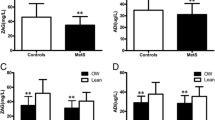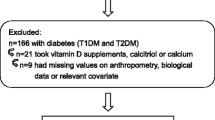Abstract
Although zinc was known to be associated with insulin metabolism and diabetes, the relationship of serum zinc concentration with insulin resistance (IR) and metabolic syndrome (MetS) was not well investigated in general population. The aim of this study is to evaluate the relationships of serum zinc concentration with IR and MetS in a nondiabetic adult population. This cross-sectional study included 656 men and 825 women who were nondiabetic adults from the fifth Korea National Health and Nutrition Examination Survey conducted in 2010. Serum zinc concentration and metabolic parameters were measured. IR was estimated by homeostatic model assessment (HOMA2). MetS was defined according to the National Cholesterol Education Program Adult Treatment Panel III criteria. Serum zinc concentration was negatively correlated with homeostasis model assessment for insulin resistance (HOMA2-IR) in men (r = −0.104, P = 0.008), but not in women. After adjusting for conventional cardiovascular risk factors, the inverse correlation was significant in both men and women (B = −0.262, SE = 0.060 for men, and B = −0.129, SE = 0.052 for women). However, serum zinc concentration was not different between the groups with and without MetS (P = 0.752 for men and P = 0.371 for women). In conclusion, serum zinc concentration was inversely associated with IR but not related to MetS in nondiabetic adult population.
Similar content being viewed by others
References
Zalewski PD, Millard SH, Forbes IJ, Kapaniris O, Slavotinek A, Betts WH, Ward AD, Lincoln SF, Mahadevan I (1994) Video image analysis of labile zinc in viable pancreatic islet cells using a specific fluorescent probe for zinc. J Histochem Cytochem 42(7):877–884
Chimienti F (2013) Zinc, pancreatic islet cell function and diabetes: new insights into an old story. Nutr Res Rev 26(1):1–11. doi:10.1017/S0954422412000212
Roussel AM, Kerkeni A, Zouari N, Mahjoub S, Matheau JM, Anderson RA (2003) Antioxidant effects of zinc supplementation in Tunisians with type 2 diabetes mellitus. J Am Coll Nutr 22(4):316–321
Wiernsperger NF (2003) Oxidative stress as a therapeutic target in diabetes: revisiting the controversy. Diabetes Metab 29(6):579–585
Lann D, LeRoith D (2007) Insulin resistance as the underlying cause for the metabolic syndrome. Med Clin N Am 91(6):1063–1077. doi:10.1016/j.mcna.2007.06.012, viii
Yubero-Serrano EM, Delgado-Lista J, Pena-Orihuela P, Perez-Martinez P, Fuentes F, Marin C, Tunez I, Tinahones FJ, Perez-Jimenez F, Roche HM, Lopez-Miranda J (2013) Oxidative stress is associated with the number of components of metabolic syndrome: LIPGENE study. Exp Mol Med 45:e28. doi:10.1038/emm.2013.53
Anetor JI, Senjobi A, Ajose OA, Agbedana EO (2002) Decreased serum magnesium and zinc levels: atherogenic implications in type-2 diabetes mellitus in Nigerians. Nutr Health 16(4):291–300
Xu J, Zhou Q, Liu G, Tan Y, Cai L (2013) Analysis of serum and urinal copper and zinc in Chinese northeast population with the prediabetes or diabetes with and without complications. Oxidative Med Cell Longev 2013:635214. doi:10.1155/2013/635214
Marreiro DN, Geloneze B, Tambascia MA, Lerario AC, Halpern A, Cozzolino SM (2006) Effect of zinc supplementation on serum leptin levels and insulin resistance of obese women. Biol Trace Elem Res 112(2):109–118
Sun Q, van Dam RM, Willett WC, Hu FB (2009) Prospective study of zinc intake and risk of type 2 diabetes in women. Diabetes Care 32(4):629–634. doi:10.2337/dc08-1913
Hashemipour M, Kelishadi R, Shapouri J, Sarrafzadegan N, Amini M, Tavakoli N, Movahedian-Attar A, Mirmoghtadaee P, Poursafa P (2009) Effect of zinc supplementation on insulin resistance and components of the metabolic syndrome in prepubertal obese children. Hormones (Athens) 8(4):279–285
Suarez-Ortegon MF, Ordonez-Betancourth JE, Aguilar-de Plata C (2013) Dietary zinc intake is inversely associated to metabolic syndrome in male but not in female urban adolescents. Am J Hum Biol 25(4):550–554. doi:10.1002/ajhb.22408
Ghasemi A, Zahediasl S, Hosseini-Esfahani F, Azizi F (2014) Gender differences in the relationship between serum zinc concentration and metabolic syndrome. Ann Hum Biol. doi:10.3109/03014460.2013.870228
Czernichow S, Vergnaud AC, Galan P, Arnaud J, Favier A, Faure H, Huxley R, Hercberg S, Ahluwalia N (2009) Effects of long-term antioxidant supplementation and association of serum antioxidant concentrations with risk of metabolic syndrome in adults. Am J Clin Nutr 90(2):329–335. doi:10.3945/ajcn.2009.27635
Suliburska J, Cofta S, Gajewska E, Kalmus G, Sobieska M, Samborski W, Krejpcio Z, Drzymala-Czyz S, Bogdanski P (2013) The evaluation of selected serum mineral concentrations and their association with insulin resistance in obese adolescents. Eur Rev Med Pharmacol Sci 17(17):2396–2400
Ortega RM, Rodriguez-Rodriguez E, Aparicio A, Jimenez AI, Lopez-Sobaler AM, Gonzalez-Rodriguez LG, Andres P (2012) Poor zinc status is associated with increased risk of insulin resistance in Spanish children. Br J Nutr 107(3):398–404. doi:10.1017/S0007114511003114
Islam MR, Arslan I, Attia J, McEvoy M, McElduff P, Basher A, Rahman W, Peel R, Akhter A, Akter S, Vashum KP, Milton AH (2013) Is serum zinc level associated with prediabetes and diabetes?: a cross-sectional study from Bangladesh. PLoS One 8(4):e61776. doi:10.1371/journal.pone.0061776
Singh RB, Niaz MA, Rastogi SS, Bajaj S, Gaoli Z, Shoumin Z (1998) Current zinc intake and risk of diabetes and coronary artery disease and factors associated with insulin resistance in rural and urban populations of North India. J Am Coll Nutr 17(6):564–570
Expert Panel on Detection E, Treatment of High Blood Cholesterol in A (2001) Executive summary of the third report of the National Cholesterol Education Program (NCEP) expert panel on detection, evaluation, and treatment of high blood cholesterol in adults (adult treatment panel III). JAMA 285 (19):2486–2497
Lee SY, Park HS, Kim DJ, Han JH, Kim SM, Cho GJ, Kim DY, Kwon HS, Kim SR, Lee CB, Oh SJ, Park CY, Yoo HJ (2007) Appropriate waist circumference cutoff points for central obesity in Korean adults. Diabetes Res Clin Pract 75(1):72–80. doi:10.1016/j.diabres.2006.04.013
Institute NRRD (2006) Food composition table. 7 edn., Suwon Korea
Van der Schouw YT, Verbeek AL, Ruijs JH (1992) ROC curves for the initial assessment of new diagnostic tests. Fam Pract 9(4):506–511
Simon SF, Taylor CG (2001) Dietary zinc supplementation attenuates hyperglycemia in db/db mice. Exp Biol Med (Maywood) 226(1):43–51
Farvid MS, Siassi F, Jalali M, Hosseini M, Saadat N (2004) The impact of vitamin and/or mineral supplementation on lipid profiles in type 2 diabetes. Diabetes Res Clin Pract 65(1):21–28. doi:10.1016/j.diabres.2003.11.009
Gunasekara P, Hettiarachchi M, Liyanage C, Lekamwasam S (2011) Effects of zinc and multimineral vitamin supplementation on glycemic and lipid control in adult diabetes. Diabetes Metab Syndr Obes 4:53–60. doi:10.2147/DMSO.S16691
Yu Y, Cai Z, Zheng J, Chen J, Zhang X, Huang XF, Li D (2012) Serum levels of polyunsaturated fatty acids are low in Chinese men with metabolic syndrome, whereas serum levels of saturated fatty acids, zinc, and magnesium are high. Nutr Res 32(2):71–77. doi:10.1016/j.nutres.2011.12.004
Obeid O, Elfakhani M, Hlais S, Iskandar M, Batal M, Mouneimne Y, Adra N, Hwalla N (2008) Plasma copper, zinc, and selenium levels and correlates with metabolic syndrome components of Lebanese adults. Biol Trace Elem Res 123(1–3):58–65. doi:10.1007/s12011-008-8112-0
Pizent A, Pavlovic M, Jurasovic J, Dodig S, Pasalic D, Mujagic R (2010) Antioxidants, trace elements and metabolic syndrome in elderly subjects. J Nutr Health Aging 14(10):866–871
Koo SI, Ramlet JS (1983) Dietary cholesterol decreases the serum level of zinc: further evidence for the positive relationship between serum zinc and high-density lipoproteins. Am J Clin Nutr 37(6):918–923
Freeland-Graves JH, Friedman BJ, Han WH, Shorey RL, Young R (1982) Effect of zinc supplementation on plasma high-density lipoprotein cholesterol and zinc. Am J Clin Nutr 35(5):988–992
Hooper PL, Visconti L, Garry PJ, Johnson GE (1980) Zinc lowers high-density lipoprotein-cholesterol levels. JAMA 244(17):1960–1961
Haase H, Maret W (2005) Protein tyrosine phosphatases as targets of the combined insulinomimetic effects of zinc and oxidants. Biometals 18(4):333–338. doi:10.1007/s10534-005-3707-9
Tang X, Shay NF (2001) Zinc has an insulin-like effect on glucose transport mediated by phosphoinositol-3-kinase and Akt in 3 T3-L1 fibroblasts and adipocytes. J Nutr 131(5):1414–1420
Levine AS, McClain CJ, Handwerger BS, Brown DM, Morley JE (1983) Tissue zinc status of genetically diabetic and streptozotocin-induced diabetic mice. Am J Clin Nutr 37(3):382–386
Krebs NF (2000) Overview of zinc absorption and excretion in the human gastrointestinal tract. J Nutr 130(5S Suppl):1374S–1377S
DeFronzo RA, Tobin JD, Andres R (1979) Glucose clamp technique: a method for quantifying insulin secretion and resistance. Am J Physiol 237(3):E214–E223
Wallace TM, Levy JC, Matthews DR (2004) Use and abuse of HOMA modeling. Diabetes Care 27(6):1487–1495
Author information
Authors and Affiliations
Corresponding author
Rights and permissions
About this article
Cite this article
Ahn, BI., Kim, M.J., Koo, H.S. et al. Serum Zinc Concentration Is Inversely Associated with Insulin Resistance but Not Related with Metabolic Syndrome in Nondiabetic Korean Adults. Biol Trace Elem Res 160, 169–175 (2014). https://doi.org/10.1007/s12011-014-0045-1
Received:
Accepted:
Published:
Issue Date:
DOI: https://doi.org/10.1007/s12011-014-0045-1




